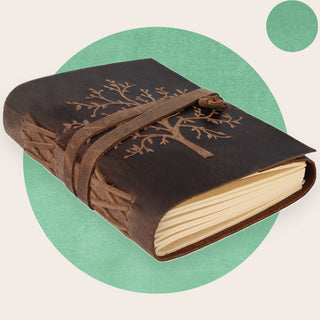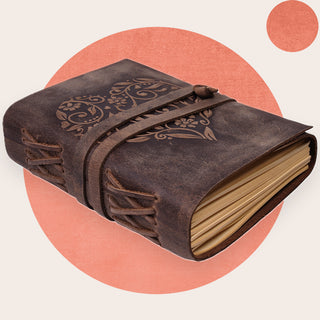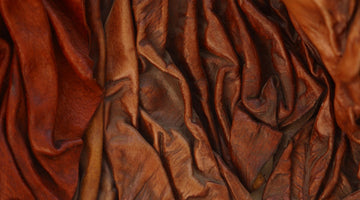Are you one of those so-called visual learners? Have you tried regular journaling but struggled to connect with it because of its lack of visual elements? Would you prefer to use a visual journal to get the job done?
Well, worry no longer, for today we will be exploring five key tips for starting your very own visual journal, whether you are simply a better visual journaler or someone interested in the visual arts.
Starting a visual journal has never been easier thanks to these 5 helpful tips for getting started.
1. Notebook
This is arguably the most important part of the whole creative process - where would you be in your visual journaling enterprise without a journal that could really keep up with your needs and wants?
The ideal notebook here is one that you can keep with you wherever you go. For this reason, it will need to be aptly sized. Many opt to use massive A3 or A4 visual journals and, though this will give you a far larger forum within which to capture a visual journal entry, you are going to find it a considerable amount more difficult to carry around with you.
Try out a few different sizes of journals in their cheaper versions until you find the right one for you. In using the cheaper versions, you can be sure that you aren't investing in an expensive journal whose size you might not wish to continue using for too long, thereby saving you money along the way.
The last thing you want your journaling practice to be, no matter whether it's a mood journal or a recipe journal, is a financial sinkhole!

2.Trusting Yourself
As with all other journals, art journals are inherently about what you like and prefer, in this case visually, using those instinctive desires to learn more about yourself. The one thing a prospective journaler is bound to get stuck on is the very beginning, knowing where exactly to start and what exactly to begin writing.
Prompts can only get you so far - you must, at some point, learn to trust yourself and your own instincts and fill those sketchbook pages with things that you actually want to fill them with.
If you are really having trouble knowing where to start, then why not try:
- writing down a quote that feels in some way significant to you
- capturing some memories of the day thus far
- any tasks that need completing tomorrow
- mind mapping a new or present project
- scribbling the incomplete fragment of a new idea
- tracking a new habit you would like to add to your routine
Even if it feels disjointed at first, it will come to make some sort of sense at some point. This journal is like the constellations and you are the earth viewing from the center of itself - it will only make sense from your point of view, and that's okay.
3. When to Color
Black text is just about anywhere you can imagine. It is the primary ink by which we interpret the textual symbols and logos throughout the world. In this way, black text is often thought of as information to process and should be treated as such. Color should be used as sparingly as possible, so put away those colored pencils unless you have a specific thing to address.
The natural contrast between black ink and white paper is usually the perfect combination for normative eyes, so any color should be used when it is really necessary, especially in the highlighting of certain things that need addressing.
This is usually in the case of headings, borders, drawings, etc., though the opportunities are endless.
Heck, you might even be so used to using color and dry media to convey your message that black is less normal to you, in which case you might as well swap out all appearances of black and color above. In this way, black is the one to use sparingly when you draw and such and color is the one to use at all times.
4. Headings
Speaking of which, it is worth using a heading on as many pages as you can muster. Headings are just a great way of bookmarking your place in the journal and making sure your future self knows where to come back to when looking for a certain thing, hence why it is often useful to some to use color to highlight these headings for greater ease of use.
As well as helping you to return to a certain point later, it can also help information stick a little easier to your brain when you create headings in this way. You are categorizing information ready for processing later down the line as well as ensuring that the information is more adhesive in the first place, killing two birds with one stone.

5. Bad & Good
Before you officially begin, you should allow yourself to make some bad drawings. The best part about having your own visual journal is that you can afford to make mistakes within this forum. That's kind of what it's for. Much as a jazz musician forges forward into new territory through their mistakes, an artist should also seek to use their life and page to create new things like so.
In this way, mistakes are not merely okay, they should be actively encouraged, for they themselves will ultimately encourage the new, even if not immediately. Use your images and ability to write to make something new for goodness sake! Words, painting, collage, all are manners of creating something new.
Final Words
So, there you have it! Hopefully, you are now feeling ready and able to start your own visual journal!
FAQs Visual Journal
WHAT IS A VISUAL JOURNAL?
A visual journal is a journal whose central bent is to include visual elements into the usual journaling format. This is especially useful if you have an expensive art sketchbook that you don't want to put your initial drawings into. In this way, you can use a visual journal to carve out your drafts for future inclusion.
HOW DO YOU CREATE A VISUAL JOURNAL?
Creating a visual journal is as easy as staying true to yourself (which is in itself a rather difficult task). The key to creating any good journal is to focus your attention on the things you like and desire. It's no use following a bunch of old and crusty journal prompts to paint with if they aren't what you are interested in artistically.
WHAT SHOULD BE IN A VISUAL DIARY?
This will depend entirely on what you are interested in. What is interesting to one person will inherently not be so interesting to another unless, of course, you have found your artistic soulmate.
WHAT'S THE PURPOSE OF KEEPING A VISUAL JOURNAL?
Those who keep a visual journal will inherently be those who learn better visually or who are otherwise interested in the visual arts. Those whose ideas are ripe for exploring in visual mediums such as this will naturally gravitate toward a visual journal for the ripe capturing of their ideas. Examples of such enterprises are all over the internet, but none will be as relevant to you as your own.



